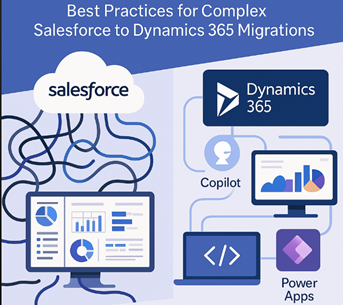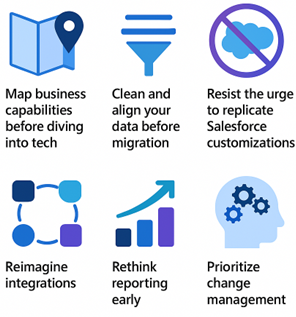Lessons I've Learned Migrating Complex Salesforce Solutions to Dynamics 365

Having architected and led enterprise-scale Salesforce-to-Dynamics 365 migration programs, I’ve witnessed firsthand the challenges organizations face when modernizing their CRM. These initiatives are far more than a simple data transfer—they represent a rare opportunity to eliminate years of technical debt, streamline operations, and drive measurable business impact.
In my experience, success is defined by outcomes such as:
- 30–60% reduction in unnecessary customizations,
- Faster reporting cycles with unified Power BI dashboards, and
- Improved user adoption through simplified processes and change management.
But even the best technical plans can falter if legacy processes, forgotten customizations, and unstructured data are carried forward without rethinking the bigger picture. A true transformation requires reimagining both technology and the business processes it enables.
When an organization is modernizing by moving from an outmoded Salesforce solution to Dynamics 365 Customer Engagement, they are not just moving data. Typically, they have arrived at their decision to take on this initiative after hearing from users and stakeholders around the organization, from IT to sellers to analysts to marketers, that the CRM status quo has become a liability. Wading into the project, they must untangle a web of details woven over years of operational decisions, business structure updates, and leadership changes.
A team taking on such a typical project of this type will come face to face with:
- Custom objects, code, and automation that no one remembers building
- Integrations with finance, operations, marketing, and external partners
- Reports and dashboards that users depend on daily
- Processes that feel “set in stone” to long-time teams
All of this usually comes with executive pressure: “Make it seamless. Don’t disrupt operations. And can we go live in six months?”
Best Practices for a Successful Migration
These six best practices capture the most impactful lessons from real-world Salesforce-to-Dynamics 365 migrations, helping organizations reduce technical debt, improve reporting, and accelerate adoption.

1. Map business capabilities before diving into tech
Start with business outcomes rather than object-to-object mappings. By aligning processes and goals first, you prevent simply recreating legacy technical debt in Dynamics 365.
When assessing an older Salesforce environment, I often uncover:
- Custom objects, workflows, and code that no one actively maintains
- Redundant fields or duplicate data models created to solve one-off requests
- Outdated or manual processes that have become “invisible” to the team
- Reports and dashboards that reveal how users actually interact with the system
Documenting these findings not only guides the migration design but also sparks conversations about process simplification and modernization before any data moves.
2. Clean and align your data before migration
Legacy Salesforce data is rarely “migration-ready.” It often contains duplicate records, abandoned fields, inconsistent picklists, and conflicting definitions that have accumulated over years of reactive changes. Moving this clutter into Dynamics 365 only carries forward technical debt.
To ensure a clean start:
- Audit your data model – Identify unused fields, outdated record types, and inactive objects.
- Standardize and deduplicate records using Dataflows, Power Query, or Azure Data Factory before loading into Dataverse.
- Engage business owners early to validate which fields, values, and records are truly needed.
In one enterprise migration, we uncovered:
- 200+ unused custom fields
- 40+ orphaned automation rules that no one could explain
Instead of replicating this noise in Dynamics 365, we partnered with business leads to streamline processes, reduce the number of custom entities by 60%, and deliver a faster, more maintainable system post-launch.
A disciplined data-cleaning phase not only improves performance and reporting but also ensures your new CRM starts with trustworthy, adoption-ready data.
3. Resist the urge to replicate Salesforce customizations 1:1
Avoid replicating every Salesforce customization object-for-object. Instead, leverage native Dynamics 365 features like Business Process Flows, model-driven Power Apps, and Dataverse relationships to modernize and simplify.
In older Salesforce environments, we often encounter:
FREE Membership Required to View Full Content:
Joining MSDynamicsWorld.com gives you free, unlimited access to news, analysis, white papers, case studies, product brochures, and more. You can also receive periodic email newsletters with the latest relevant articles and content updates.
Learn more about us here